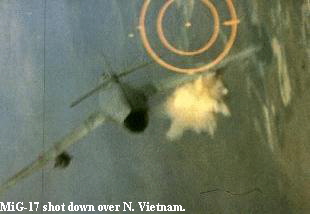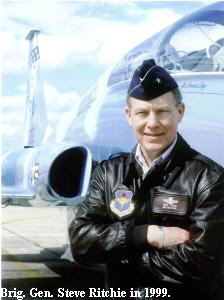|
Other Stories
 
Vietnam
   
|

USAF Jets in Combat
|
|
|
An F-4 Phantom II, pictured right, from Luke Air Force Base, in Arizona, flies over the desert. Similar F-4s were used during combat in Vietnam -- U.S. Air Force Photograph
|
Death of a MiG and a Friend
|
|
|
By Shelby G. Spires
sgspires@bellsouth.net
It was a bitter sweet time for the United States Air Force's only Vietnam ace
after he blew his first MiG out of the sky on May 10, 1972.
It was on that
day then-Capt. Steve Ritchie, USAF, not only scored his first MiG-21 kill but
lost his good friend and squadron mate Maj. Bob Lodge to enemy fire.
"We were
going to meet a flight of MiG-21s head on, and we did meet MiGs head on back
then," now retired U.S. Air Force Reserve Brig.Gen. Ritchie said. "We knew the
MiGs would be orbiting in a confirmed area, and we were going after them."
For several days intelligence and mission planners of the 432nd
Tactical Fighter/Recon naissance Wing has been gathering data on the aircraft
type, location and flight patterns of the Russian made aircraft, Ritchie said.
They were looking to protect the bombers on the kickoff to the original
Linebacker assault. May 10, 1972 was one of the more important days of the war.
It was the most intense day of air combat during the Vietnam conflict, many
feel.
Ritchie and his air combat crew brethren were tired of taking it from
the MiG drivers. It was Air Force's turn to give it back to the North
Vietnamese.
That day, in Oyster flight, Ritchie was flying in the number
three slot of a four aircraft flight. Their job was to draw the orbiting MiGs
away from another flight of F-4s that were to drop laser guided bombs on a Hanoi
target.
The mission was part of the Linebacker campaign -- which was a series
of intensive bombing sorties on North Vietnam designed to bring them to the
Paris peace table.
"We were orbiting at about 300 feet, about 30 miles west
of 'Bullseye' or Hanoi," Ritchie said. "Then we picked up the MiGs orbiting
northwest of Hanoi."
The plan was to monitor the MiGs until the pilots of the
Russian aircraft moved to attack the incoming strike force, Ritchie
said.
"Bob Lodge was leading the flight in Oyster One, and I was the deputy
flight leader in the number three position," Ritchie said "The plan called for
lead and two to fire at the MiGs head on at a range of about seven
miles."
The F-4s went head on with the MiG-21s and as planned Lodge and his
wingman fired off their radar controlled AiM-7 Sparrow missiles. The pilots got
their warbling tones, and after pressing the triggers the Sparrows dropped from
the underside Phantom missile wells. Locking onto the radar beam, the missiles
accelerated to terminal speed and sought their targets -- a pair of
MiG-21s.
Homing in on the enemy aircraft, the Sparrows did their jobs that
day -- a rare thing during the Vietnam War because the radar missiles had a
reputation for being unreliable. The MiGs were blown out of the sky when the
missiles explosions tore into the thin metal fuselage of the aircraft.
Two
others were left. Ritchie said the flight went after the remaining MiGs.
"We
turned as hard as we could to get behind the MiGs," he said. "At that point I
managed to get a lock on one of the remaining planes and I fired off two
missiles."
Ritchie said the missiles were fired at the minimum limit of their
radar parameters. The second Sparrow exploded under the third MiG. The expanding
steel of the the blast fragmented -- doing its job and thrashing the MiG full of
holes. Smoking, venting fuel and on fire, the MiG began a death spiral to the
ground below. The  pilot managed to eject. pilot managed to eject.
Meanwhile, Lodge and his
backseater Roger Locher, were intent on knocking out a fourth MiG, Ritchie said.
"We saw a flight of MiG-19s coming in from behind readying for an attack on
Oyster One," Ritchie said. "We screamed over the radio for them to break off the
attack, but as happens even with the best pilots they had what we call `target
fixation' on that last MiG."
The incoming MiGs pounced on Lodge and Locher.
The attacking pilots pressed the triggers activating the MiG-19s powerful
cannons, and covered the American Phantom with 37mm cannon fire. A tough machine
the Phantom, but the blasts were too much for it. The rounds pummeled the twin
engine fighter; the beating was incredible, and the machine was flipped over.
Lodge and Locher were stuck in a death trap. Ritchie said he saw the American
fighter plummeting out of the sky upside down and on fire.
Ritchie said the
last MiG-21 along with the MiG-19s chased the rest of the Oyster flight out.
Locher managed to eject, but Lodge was battling the aircraft, and rode it
in.
"With over 400 missions, they were considered the best aircrew in
Southeast Asia by some," he said. "It just goes to show you what can happen even
with the most experienced crews."
The story doesn't end with Ritchie. Locher
managed to eject. The canopy was bubbling from the heat of the aircraft fire. He
called Lodge on the intercom and told him he was leaving the aircraft. Ejecting,
Locher managed to get out of the aircraft safely, intact. Important back then
because the Phantom ejection seat -- the Martin-Baker -- had a nasty habit of
tearing off legs and arms snagged during the ejection process.
Locher hit
the ground running -- literally. The weapons system operator came down in a bowl
like basin. He fell back on his escape and evasion training, and what is one of
the most magnificent stories of the war, Locher managed to evade capture by the
North Vietnamese. After 23 days in the jungles of North Vietnam, Roger Locher
was rescued. "That was a great day when we snatched him from the jungle, but it
was still a bitter sweet time because of the loss of (Lodge)," Ritchie
said.
Ritchie went on to blow four more MiG-21s out of the communist held
skies of North Vietnam -- making him the only Air Force ace pilot to come out of
the Vietnam war.
"I am the only ace pilot to shoot down five MiG-21s, and the
day after I shot down the last one, there was an order waiting for me. It
instructed me not to fly any more. They (DoD officials) felt like, since I was
the only MiG-21 ace, that if I were to be shot down it would be a great
propaganda victory."
Almost three decades later, the environment has changed
in the United States Air Force.
"The planes we have today," Ritchie said
after a ride in an F-16, "are a quantum leap over what we had when I flew in
Vietnam."
The training today's fighter pilots also rank with the craft they
fly -- the best, Ritchie said. It was not always that way. When Ritchie was
coming through pilot training conventional "wisdom" of the time dictated that
there was not need for air combat maneuvering. No need to practice the 50 years
of lessons learned since men and machines took to the skies to wage war over the
Flanders Field in France. Aircraft designers of the time thought the mighty
missile would do everything that was needed.
Men paid for those lessons with
their blood and freedom.
Ritchie remembered the times with a tinge of
bitterness to his voice. "Until I was over Hanoi, I never saw a dissimilar
aircraft," Ritchie said. "We just didn't train that way 30 years ago."
One of
the reasons training was hampered back then, Ritchie said, was because Air Force
officials felt like danger involved in that type of aerial maneuver training
would cause in-flight accidents.
"But that just isn't so," Ritchie said. "We
train our pilots with aggressor squadrons and dissimilar aircraft and our pilots
are better trained and the accident rate is lower now than it was then."
In a
letter to Air Force officials, after he returned from Vietnam, Ritchie and other
combat pilots recommended several changes to the way the Air Force trains
pilots. One of those recommendations, he said, was the use of aggressor
squadrons.
"Soon after that, the Air Force began flying the `Red Flag'
missions out at Nellis (Air Force Base, in Nevada)," he said.
Ritchie said
the lessons learned from Vietnam lead to the stunning victories in the Persian
Gulf War.
"You bet it did," he said. "We basically did everything wrong in
Vietnam and did everything right in the Gulf," he said. "We were sent to Vietnam
and told to fight, but we were not allowed to win. That is immoral."
|
All Text and Design Copyright (c) 2005 Shelby G. Spires. All rights reserved.
sgspires@sgspires.com |









